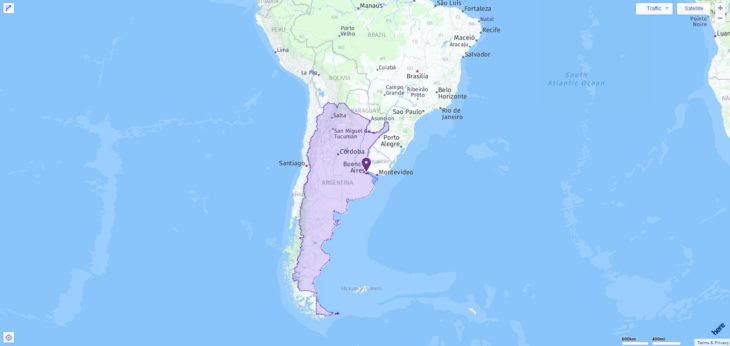Your search found 2 matches. The following is the full list of ACT testing locations in Argentina among which you can pick one to take the exam. Please know that on the test day, test takers can use any 4-function, scientific, or graphing calculator. On the table below, you can also find all test dates through 2019.

2019-2020 ACT Test Dates in Argentina
| Test Date | Registration Deadline |
| February 9, 2019 | January 11, 2019 |
| April 13, 2019 | March 8, 2019 |
| June 8, 2019 | May 3, 2019 |
| July 13, 2019 | June 14, 2019 |
| September 14, 2019 | August 16, 2019 |
| October 26, 2019 | September 20, 2019 |
| December 14, 2019 | November 8, 2019 |
| February 8, 2020 | January 10, 2020 |
| April 4, 2020 | February 28, 2020 |
| June 13, 2020 | May 8, 2020 |
| July 18, 2020 | June 19, 2020 |
ACT Test Centers in Argentina
| City | Center Name | Center Code |
| Buenos Aires | Asociacion Escuelas Lincoln | 865020 |
| Mendoza | BNC A.M.I.C.A.N.A. | 872430 |
More about Argentina
Business
Argentina differs from many emerging economies because its equipment of production factors corresponds more closely to that of an industrialized country (e.g. ample availability of mainly agricultural raw materials, until the 1960s immigration mainly of well-trained skilled workers and entrepreneurs, for a long time a high level of education and social security system). However, these good prerequisites could only inadequately be converted into sustainable economic development. Argentina today can be described as a modern, but only partially developed country. Argentina is one of the emerging countries with high middle income.
Argentina was an agricultural country until the 1930s. As early as 1940, the industrial sector surpassed the agricultural sector in terms of its contribution to the gross domestic product (GDP). The dirigiste policy of the Peron era did not fulfill the hope of self-sustaining economic growth. Lack of competitiveness, low innovation dynamics and small sales markets increased the gap to international competition. The result was the economic decline of Argentina; The trend was reinforced by frequent changes of government, combined with massive changes in economic and socio-political course, as well as ongoing distribution conflicts between social groups. All of the restructuring and debt rescheduling programs have had very limited success. Between 1980 and 1990 GDP fell steadily, the inflation rate averaged more than 400%, reaching almost 5,000% in 1989; the foreign debt rose dramatically.
Since the beginning of the 1990s there has been a fundamental economic reorientation, including: Liberalization of the economy and privatization of state-owned companies. As a result of ongoing political and economic instability, especially since the mid-1990s (severe economic and financial crisis), economic growth stagnated and foreign debt increased significantly. The economic crisis that lasted from 1998–2002 had various causes: Due to the overvaluation of the currency as a result of the dollar peg, the Argentine economy lost massively in international competitiveness, especially compared to Brazil and within Mercosur. This and the one-sided trade liberalization resulted in massive de-industrialization. At the same time, the falling capital inflows from abroad had been compensated for by new government debt, which caused the debt level to rise to 146 billion dollars at the end of 2001, so that Argentina had to declare itself insolvent. To overcome the financial and economic crisis, the peg of the Argentine peso to the dollar was abolished and the de-dollarization of the Argentine economy was initiated. By mid-2002 the economy had stabilized again at a low level.
From 2002 to 2007 the country recorded strong economic growth of over 8% annually, before consolidation set in in the following years (2010: 3.5%, 2017: 2.9%). At 25.7% (2017), the inflation rate is very high; the unemployment rate is (2017) 8.7%. The disparate distribution of income continues to be problematic; officially around 5% of the population live below the poverty line; According to independent estimates, at least a quarter of Argentines are affected. In July 2014, the country went into default a second time when US hedge funds insisted on paying $ 1.5 billion. Gross external debt had risen to around US $ 307 billion by mid-2017. Under President M. Macri Therefore, there was a change in economic policy towards the reduction of subsidies, liberalization and integration into the world market. The resulting social cuts led to nationwide protests (general strike in June 2018).
Foreign trade: With a few exceptions, Argentina’s trade balance has been positive since 1965. As a result of liberalization measures by the Menem government, imports in particular rose sharply, which resulted in a largely negative balance up to 1999. Since then, it has been positive as a result of rising raw material prices (2016 imports: US $ 53.2 billion, exports: US $ 57.8 billion). The main import goods are chemical products, machines, instruments and electronics, intermediate products for industry, petroleum and transportation equipment. The main exports are motor vehicles, mining products, vegetable products, foodstuffs and luxury goods. The creation of Mercosur (members: Argentina, Brazil, Paraguay, Uruguay ) has greatly stimulated trade between these countries. By far the most important trading partner is Brazil, as well as China and the USA.

